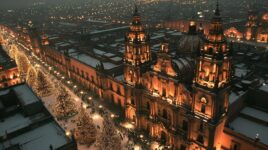
Como Se Celebra La Navidad en Mexico
Christmas in Mexico, or “como se celebra la navidad en mexico,” is a time of joy, tradition, and celebration. The holiday holds great significance for the Mexican people, and it is marked by a rich tapestry of customs and rituals that have been passed down through generations. From the history and preparations to the decorations, food, and music, Christmas in Mexico is a truly unique experience that reflects the country’s cultural heritage.
The celebration of Christmas in Mexico is deeply rooted in both religious and cultural traditions. It is a time for families to come together and honor the birth of Jesus Christ, while also partaking in festive activities that have been cherished for centuries. The customs associated with Christmas in Mexico are a blend of indigenous Mesoamerican traditions and Spanish influences brought over during the colonial period.
Throughout this article, we will delve into the various aspects of celebrating Christmas in Mexico. We will explore the history of Christmas in Mexico, detailing its origins and evolution over time. Additionally, we will examine the preparations leading up to Christmas, including the tradition of Posadas, which plays a central role in Mexican Christmas celebrations.
Furthermore, we will discuss the vibrant decorations that adorn homes and public spaces during the Christmas season in Mexico, as well as the delicious traditional dishes and drinks enjoyed during this festive time. The significance of attending Midnight Mass on Christmas Eve will also be explored, along with traditions surrounding gift-giving and music and dance festivities.
Finally, we will delve into the unique customs associated with the Day of the Three Kings on January 6th. Gathered together, these traditions reflect a rich cultural heritage that makes celebrating Christmas in Mexico a truly special experience.
History of Christmas in Mexico
The history of Christmas in Mexico is a rich and vibrant tapestry that reflects the country’s unique blend of indigenous, European, and Christian traditions. The celebration of Christmas, or “Navidad” as it is known in Spanish, holds great significance for the people of Mexico, marked by a variety of customs and festivities that have evolved over centuries.
The origins of Christmas in Mexico can be traced back to the period of Spanish colonization in the 16th century when Catholic missionaries introduced the holiday to the indigenous population. In an effort to convert the native people to Christianity, the missionaries incorporated elements of indigenous winter solstice celebrations into the Christmas traditions, creating a unique fusion of cultures.
One significant aspect of this fusion is the tradition of Las Posadas, which reenacts Mary and Joseph’s search for shelter before the birth of Jesus. This nine-day celebration begins on December 16th and culminates on Christmas Eve with a festive reenactment, followed by a party featuring traditional food and piñatas. The Posadas highlight the blending of indigenous and Christian beliefs and have become an integral part of Mexican Christmas celebrations.
Another important element in the evolution of Christmas in Mexico is the influence of Mexican folk art and craftsmanship. This is evident in the colorful decorations that adorn homes and public spaces during the holiday season. Intricately designed nativity scenes known as “nacimientos” are a common sight, often featuring handmade clay figurines depicting scenes from the biblical story of Jesus’ birth.
In addition to these cultural influences, Mexican Christmas traditions also incorporate elements from European customs brought over by Spanish colonizers. This can be seen in the elaborate midnight mass services held on Christmas Eve, where families come together to attend church and celebrate the birth of Jesus. These services are often followed by large feasts featuring traditional dishes such as tamales, pozole, and buñuelos – all beloved staples of Mexican holiday cuisine.
Overall, the history of Christmas in Mexico is characterized by a dynamic interplay between indigenous, European, and Christian influences that have shaped its unique customs and traditions. From Las Posadas to midnight mass to festive decorations and delicious cuisine, each aspect reflects a rich cultural heritage that continues to be celebrated with joy and reverence throughout Mexico.
| Aspect | Description |
|---|---|
| Las Posadas | A nine-day celebration reenacting Mary & Joseph’s search for shelter |
| Nativity Scenes | Intricately designed handcrafted displays depicting scenes from Jesus’ birth |
| Midnight Mass | Elaborate church services attended by families on Christmas Eve |
| Holiday Cuisine | Traditional dishes such as tamales, pozole & buñuelos enjoyed during feasts |
Preparations for Christmas
In the weeks leading up to Christmas, Mexico comes alive with vibrant customs and activities that set the stage for the holiday season. The preparations for Christmas in Mexico begin in early December, as families and communities come together to partake in various traditions that have been passed down through generations. These customs not only illustrate the deep-rooted significance of the holiday but also bring people closer through shared experiences and celebrations.
One of the most iconic customs leading up to Christmas is the tradition of Las Posadas, which begins on December 16th and continues for nine nights until Christmas Eve. This reenactment of Mary and Joseph’s search for shelter has been a hallmark of Mexican Christmas celebrations since colonial times.
Each night, a different household hosts a Posada, where participants gather outside the host’s home and take part in a procession that culminates in prayer, songs, and finally, breaking piñatas filled with fruits and candies.
Another important aspect of the preparations for Christmas in Mexico is the creation of nativity scenes or “nacimientos,” which are prominently displayed in homes, churches, and public spaces throughout the country. These intricate representations of the birth of Jesus often feature handcrafted figurines known as “pastorelas” (shepherds), “reyes magos” (three wise men), and other characters associated with the Nativity story.
Families take great care in setting up these displays, often adding elements such as miniature landscapes, water features, and traditional Mexican architecture to evoke an authentic scene from Bethlehem.
In addition to these time-honored traditions, Mexicans also engage in festive activities such as decorating their homes with lights and colorful paper lanterns called “farolitos,” shopping for gifts and traditional holiday foods at local markets, attending special events hosted by community organizations or churches, and participating in volunteer opportunities that aim to spread joy to those less fortunate during this time of year.
The spirit of giving back is central to Mexican Christmas preparations, as individuals seek out ways to share their blessings with others.
As December unfolds, these preparatory customs not only create an atmosphere of anticipation but also serve as reminders of the values and traditions that have shaped Mexican society over centuries. Ultimately, they pave the way for the joyful festivities that define how Christmas is celebrated in Mexico.
Posadas
Origin and Significance
Posadas is a tradition that holds great significance in Mexican Christmas celebrations. This reenactment of Mary and Joseph’s search for shelter originated in Spain, but has become an integral part of the holiday season in Mexico. The tradition typically takes place from December 16th to 24th, with each night representing one of the nine months of Mary’s pregnancy with Jesus.
Traditional Procession
During Posadas, neighborhoods or communities come together to form a procession. The participants are divided into two groups: the “pilgrims” who represent Mary and Joseph, and the “innkeepers” who refuse them shelter until reaching the designated location. There are often songs sung by both groups as they go from house to house seeking lodging.
The Role of Piñatas
One of the most iconic elements of Posadas is the piñata. These brightly colored figures often take the shape of a star with seven points, which represent the seven deadly sins. As part of the tradition, children are blindfolded and take turns trying to break open the piñata filled with fruits, candies, and other treats.
Celebration and Fellowship
Once a home finally opens its doors to Mary and Joseph (symbolized by offering shelter), everyone gathers inside for food, drink, music, and prayer. Tamales, punch (ponche), and other traditional Christmas foods are often served as part of the celebration.
Religious Reflection
The underlying purpose of Posadas is not only to commemorate Mary and Joseph’s journey but also to promote community bonding during the Advent season. This celebration sets the stage for more religious activities leading up to Christmas Day and encourages reflection on spiritual values.
The tradition of Posadas is deeply ingrained in Mexico’s cultural fabric, combining religious devotion with community fellowship and merry festivities. Understanding its origins and significance adds depth to anyone celebrating Christmas in Mexico or wanting to learn more about how this holiday is observed in another culture.
Decorations
Christmas in Mexico is a colorful and vibrant celebration filled with beautiful decorations that adorn homes and public spaces. The festive decorations play a significant role in setting the joyful atmosphere for the holiday season, and they are an integral part of Mexican Christmas traditions.
Seasonal Greenery and Nativities
One of the most iconic decorations seen in Mexico during Christmas is the use of seasonal greenery such as poinsettias, also known as “Flores de Nochebuena” or Christmas Eve flowers. These vibrant red flowers are native to Mexico and are prominently displayed in homes, churches, and public spaces. Additionally, nativity scenes or “Nacimientos” are popular decorations that depict the birth of Jesus and are often intricately crafted and displayed in homes and public areas.
Piñatas and Papel Picado
Colorful piñatas are a common sight during Christmas celebrations in Mexico, particularly during the Posadas. These traditional Mexican decorations come in various shapes and designs and are often filled with candies, fruits, and small toys. In addition to piñatas, papel picado or elaborately cut paper banners featuring intricate designs are hung as festive decorations to add a touch of color to the surroundings.
Luminarias and Farolitos
The use of luminarias (paper lanterns) and farolitos (small decorative lanterns) is another cherished tradition that adds a warm glow to Mexican Christmas celebrations. These lights are placed along streets, sidewalks, rooftops, and courtyards to create a magical ambiance reminiscent of the Star of Bethlehem guiding Mary and Joseph to Bethlehem.
In addition to these specific decorative elements, many Mexican families take great pride in embellishing their homes with bright lights, colorful ribbons, wreaths, tinsel, and other festive ornaments to infuse their surroundings with the spirit of Christmas.
Overall, these traditions make celebrating Christmas in Mexico a visually stunning experience filled with warmth, joy, and rich cultural significancecomo se celebra la navidad en mexico.
Food and Drink
Christmas in Mexico is a time of celebration, and like in many cultures around the world, food plays a central role in the festivities. The holiday season is marked by gatherings with family and friends, where traditional Mexican dishes are enjoyed alongside festive drinks. The flavors and aromas of these foods are an integral part of the Christmas experience in Mexico.
One of the most iconic dishes served during Christmas in Mexico is tamales. These are made from masa (a type of dough made from corn) that is filled with various ingredients such as meat, cheese, or vegetables, then wrapped in a corn husk or banana leaf and steamed. Tamales are a labor of love, often prepared by multiple family members as part of a communal effort before being enjoyed together during Christmas celebrations.
Another staple Christmas dish in Mexico is pozole, a soup made from hominy (dried maize kernels that have been treated with an alkali), meat (typically pork or chicken), and seasoned with chili peppers, among other ingredients. It is often served with an array of garnishes such as shredded lettuce, radishes, onion, lime, and more.
In addition to these savory dishes, sweet treats also take center stage during Mexican Christmas celebrations. Buñuelos are a popular dessert made from deep-fried dough that is thinly rolled out to achieve a crispy texture. They are often sprinkled with sugar or drizzled with syrup or honey for added sweetness.
When it comes to drinks, ponche Navideño is a beloved beverage commonly enjoyed during the holiday season in Mexico. This hot punch is made from an assortment of fruits such as guava, apple, tejocotes (a type of hawthorn fruit), prunes, and more. It is simmered with cinnamon sticks and sweetened with piloncillo (unrefined cane sugar) for a warming and flavorful drink that brings people together during Christmas festivities.
Overall, food holds great significance in Mexican culture and traditions como se celebra la navidad en mexico. During the Christmas season, it serves as a way to share love and joy with loved ones while savoring the rich culinary heritage that has been passed down through generations.
| Mexican Dish/Drink | Description |
|---|---|
| Tamales | Masa filled with various ingredients then wrapped in corn husk or banana leaf |
| Pozole | Soup made from hominy and meat served with garnishes |
| Buñuelos | Deep-fried dough sprinkled with sugar or syrup/honey |
| Ponche Navideño | Hot punch made from assorted fruits and sweetened with piloncillo |
Midnight Mass
The tradition of attending Midnight Mass on Christmas Eve is deeply rooted in Mexican culture and holds significant importance in the country’s Christmas celebrations. This solemn and festive religious service marks the beginning of the Christmas festivities and is a time for reflection, prayer, and joyful celebration.
Religious Significance
Midnight Mass, also known as “La Misa del Gallo” or Rooster’s Mass, is an integral part of Mexican Christmas traditions. It commemorates the birth of Jesus Christ and signifies the start of the Christmas holiday. The service typically includes readings from the Bible, hymns, prayers, and a sermon delivered by the priest. For many Mexicans, attending Midnight Mass is a way to express their faith and gratitude for the arrival of Jesus Christ.
Community Spirit
In addition to its religious significance, Midnight Mass also serves as a communal gathering where families and friends come together to celebrate the joyous occasion. Many churches across Mexico are adorned with beautiful decorations, including nativity scenes and twinkling lights, creating a warm and welcoming atmosphere for parishioners. After the service, people often gather to share food, exchange gifts, and enjoy each other’s company as they usher in Christmas Day.
Cultural Traditions
Mexican communities have their own unique customs associated with attending Midnight Mass. For example, some regions hold processions or reenactments of Mary and Joseph’s journey to Bethlehem before the commencement of the service. Additionally, it is common for churchgoers to bring baby Jesus figurines from their homes to be blessed during the midnight ceremony.
Spiritual Reflection
Midnight Mass provides an opportunity for individuals to pause from their busy lives and reflect on the spiritual significance of Christmas. For many Mexicans, this sacred service instills a sense of peace, hope, and unity as they come together in prayer to honor the birth of Jesus. The solemnity of Midnight Mass is contrasted with moments of joy as attendees sing carols and celebrate with loved ones.
Continued Tradition
Despite modernization and changing social dynamics in Mexico, Midnight Mass remains a cherished tradition that has been passed down through generations. Families continue to uphold this practice as a way to connect with their faith and create lasting memories during one of Mexico’s most celebrated holidays.
As one can see how
Gift-Giving
In Mexico, the tradition of giving and receiving gifts is an integral part of Christmas celebrations. The exchange of presents is a way for people to show love and appreciation for their family and friends, as well as to commemorate the gifts given to baby Jesus by the Three Wise Men. The act of gift-giving reflects the spirit of generosity and goodwill that defines the holiday season in Mexico.
Typically, children receive their gifts on January 6th, during the celebration of Día de los Reyes Magos (Day of the Three Kings). This tradition is based on the biblical story of the Three Wise Men who brought gifts to the infant Jesus.
On this day, it is customary for children to leave their shoes out, filled with hay or grass, for the camels of the Wise Men. In return, they wake up to find that their shoes have been filled with presents and toys.
During Navidad (Christmas), families may also exchange gifts on December 25th or during Nochebuena (Christmas Eve) gatherings. The custom varies from region to region and from family to family. Some families choose to hold a Secret Santa-style gift exchange, known as “amigo invisible,” where each person draws a name and buys a present for that individual. Others simply exchange gifts among immediate family members.
To help you better understand cómo se celebra la Navidad en México when it comes to gift-giving traditions, here are some key customs surrounding this practice:
- In many parts of Mexico, families gather on Nochebuena (Christmas Eve) to enjoy a festive meal together before opening their presents at midnight.
- Some people choose to give handmade or artisanal gifts as a way to support local artisans and showcase traditional Mexican craftsmanship.
- It is common for newlyweds or couples celebrating their first Christmas together to receive small monetary donations known as “aguinaldos” from close family members.
- Children often write letters or make wish lists addressed to Santa Claus or Niño Dios (Baby Jesus), requesting specific gifts they hope to receive.
The gift-giving customs in Mexico reflect both religious beliefs and cultural practices that have been passed down through generations. It is a time-honored tradition that brings joy and excitement to people of all ages during this special time of year.
Music and Dance
One of the most iconic musical traditions during the Christmas season in Mexico is the performance of villancicos, or Christmas carols. These songs are an essential part of Posadas, with groups of people going from house to house singing and reenacting the journey of Mary and Joseph in search of shelter. This communal activity not only brings together friends and family but also serves as a way to share the joyous spirit of Christmas with others.
In addition to traditional carols, Mexican Christmas music also encompasses lively dance traditions that add a festive flair to the holiday celebrations. One such dance form is known as “Los Pastoras,” a theatrical folk dance that tells the story of shepherds visiting baby Jesus. Dressed in vibrant costumes adorned with ribbons and bells, dancers perform intricate choreography accompanied by live music, creating a visual spectacle that captivates audiences.
Furthermore, regional variations in music and dance add depth and diversity to Mexican Christmas celebrations. In various parts of Mexico, indigenous traditions blend seamlessly with Catholic rituals during this time of year, resulting in unique musical performances and dance forms that showcase the country’s cultural mosaic.
To further enhance the joyful ambiance, communities across Mexico organize festive events featuring live music performances and traditional dances. These gatherings provide an opportunity for people to come together, celebrate their shared heritage, and revel in the merriment of Christmas.
Day of the Three Kings
The Day of the Three Kings, also known as El Dia de Reyes, is a significant and cherished holiday in Mexico that takes place on January 6th. This day marks the culmination of the Christmas season and is a time for families and communities to come together to celebrate the arrival of the Three Wise Men bearing gifts for the infant Jesus.
The traditions and customs associated with this special day are deeply rooted in Mexican culture and hold great importance for many people across the country.
One of the most iconic customs of El Dia de Reyes is the reenactment of the journey of the Three Kings, known as the Cabalgata or procession. In many towns and cities, elaborate parades are held featuring costumed individuals portraying the Three Kings who travel through the streets distributing sweets and small toys to children.
This colorful and lively tradition is a source of great joy for families, especially for young children who eagerly await their turn to receive gifts from the Wise Men.
Another integral part of celebrating El Dia de Reyes in Mexico is the consumption of Rosca de Reyes, a sweet bread shaped like a wreath with candied fruits on top. Baked inside this delicious pastry are small figurines representing baby Jesus, and it is customary for those who receive a slice containing a figurine to host a party known as La Fiesta de la Candelaria on February 2nd.
This tradition adds an element of surprise and excitement to the celebration as friends and family gather to enjoy Rosca de Reyes together.
In addition to partaking in these traditional customs, many Mexican families also exchange gifts on January 6th as a way of commemorating the generosity of the Three Kings. It is common for children to leave their shoes out on the eve of El Dia de Reyes in anticipation of receiving small presents from Melchior, Gaspar, and Balthazar. The act of giving and receiving gifts on this day serves as a reminder of faith, kindness, and solidarity within communities.
Overall, El Dia de Reyes offers a rich opportunity to honor age-old traditions while creating new memories with loved ones. Whether it involves participating in parades, enjoying sweet bread together, or exchanging gifts, this beloved holiday continues to hold great cultural significance throughout Mexico as it beautifully concludes the Christmas season.
Conclusion
In conclusion, celebrating Christmas in Mexico is a truly unique and special experience that is rich in tradition and vibrant in spirit. The significance of Christmas in Mexico goes beyond the religious aspect, as it is deeply rooted in the culture and history of the country. The traditions associated with the holiday have evolved over centuries, blending indigenous customs with Spanish influence to create a one-of-a-kind celebration.
The preparations for Christmas begin weeks in advance, with families coming together to decorate their homes with colorful papel picado, nativity scenes, and festive lights. The reenactment of Mary and Joseph’s search for shelter during Posadas brings communities together, fostering a sense of unity and compassion. Delicious food and drinks are an integral part of the festivities, with traditional dishes like tamales, pozole, and rompope adding flavor to the celebrations.
Attending Midnight Mass on Christmas Eve is a cherished tradition that emphasizes the spiritual importance of the holiday. The exchange of gifts on the night of January 5th during Dia de los Reyes Magos adds an extra layer of joy and excitement to the Christmas season. Music and dance play a significant role in Mexican Christmas celebrations, with lively songs and rhythmic dances bringing people together in merriment.
Overall, celebrating Christmas in Mexico offers a multi-sensory experience that captivates both locals and visitors alike. The sights, sounds, tastes, and traditions come together to create a festive atmosphere that is unparalleled.
From the warmth of family gatherings to the fervor of community Posadas, cada rincón de México has its own way of making Christmas special. It is truly a time when generosity, love, and cultural pride unite to make this holiday season memorable for all who take part in como se celebra la Navidad en México.



